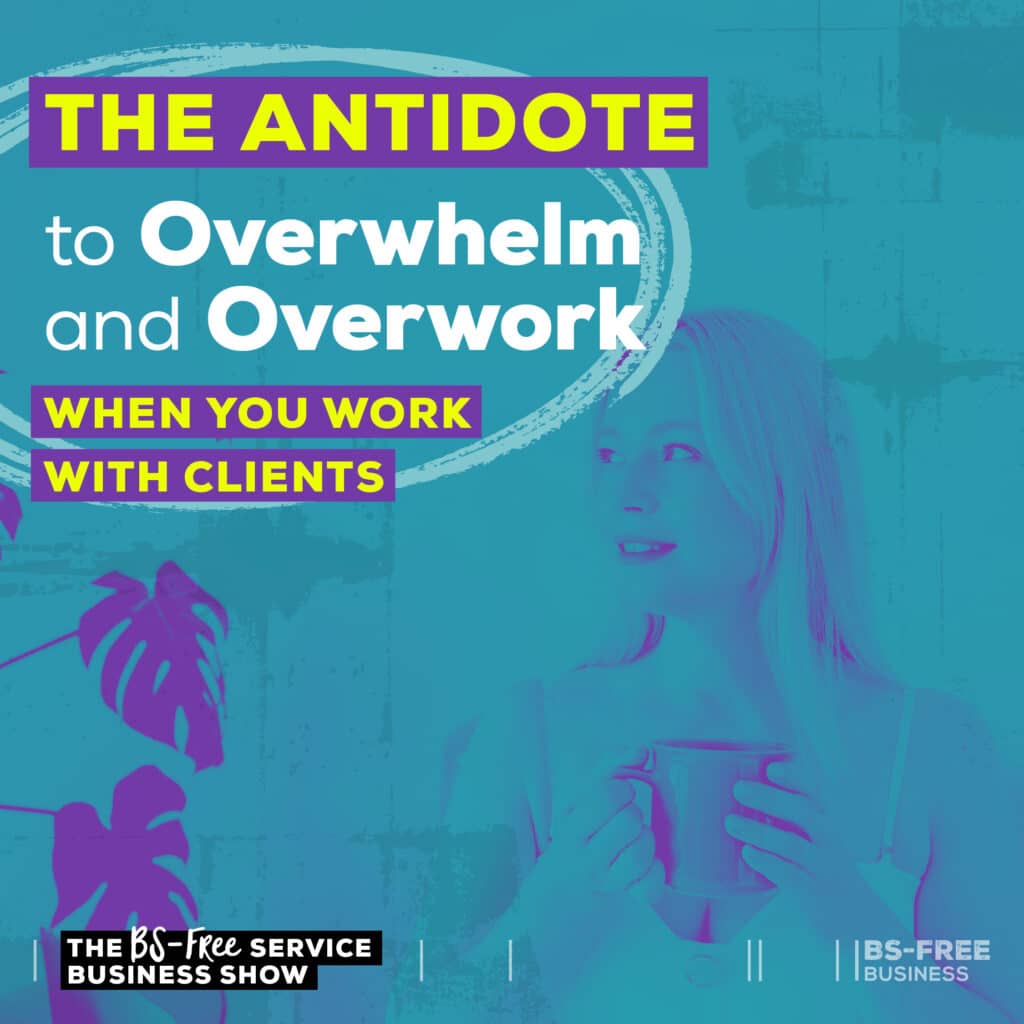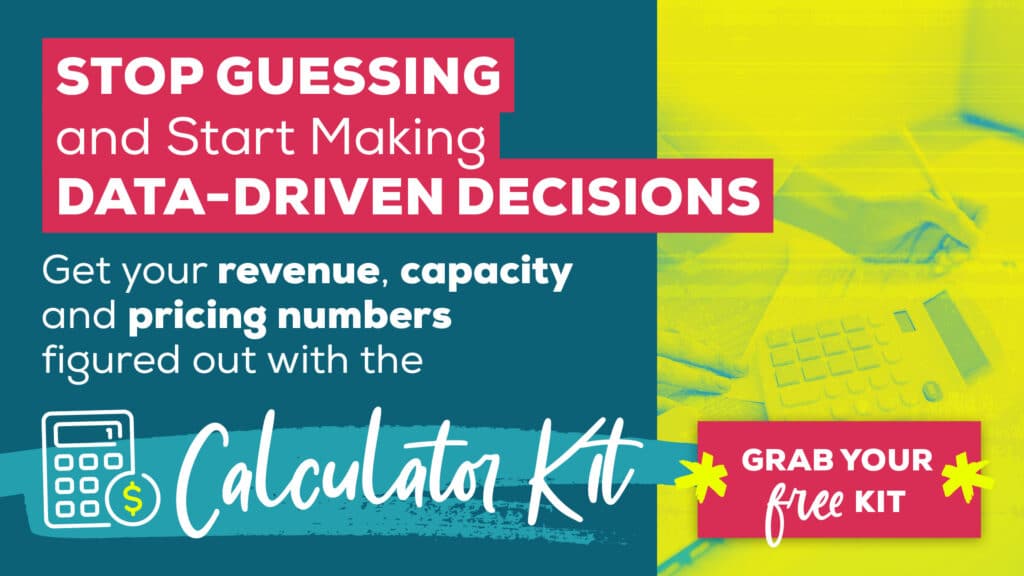
Search the site:
The Antidote to Overwhelm and Overwork When You Work With Clients
Tell me if this is familiar. You’ve made your to-do list for the week and are overwhelmed by 10 a.m. on Monday. You have no idea how in the hell you will get all of this client work done.
And working on your business? Marketing? LMAO, that’s cute.
Then the end of the week rolls around, you’re tired with a capital T, and you’re already thinking about how that to-do list never seems to end. And you’ve now got new client requests when you haven’t even gotten through this week’s list.
You’re overwhelmed and overworked but can’t escape this endless cycle of working on client deliverables.
If that’s you, it’s time for some real talk about the realities of working with clients and how you can break the overwork and overwhelm cycle for good. In this episode, we’re talking about managing your capacity in a realistic way that doesn’t mean firing all your clients or starting an entirely new business.
If you’re starting off this episode already feeling personally attacked, or like I saw your to-do list, that’s because this is a VERY common challenge for service business owners.
It doesn’t mean you can’t run your service business in a way that causes you to constantly scramble to keep up with clients and feel stretched to your limit.
Conventional online business wisdom says that when this happens you’re doomed to burn out and the only solution is to pivot into offering courses or programs.
If that’s what you want to do, I’m all for it, but you need to know that switching business models is a much bigger deal than these celebrity entrepreneurs will ever tell you. And you need to remember that they cast the service business model as the villain so they can sell you a course about creating courses or how to sell your high-ticket program.
This is some real BS, as working with clients and offering services is a proven business model that works because of its simplicity. There’s a reason I’ve tried various offers over the years, and I still offer services. I work with clients on a one-to-one consulting basis at BS-Free Business alongside programs such as the Staying Solo Squad. (Which shout-out is coming back soon, so get on that waitlist.)
You need to find a way to make working with clients work for you by finding the sweet spot between booking enough clients and being overbooked.
What makes it challenging is that there’s no clear-cut answer, so you’re left to decide if you should push through or risk having too much free time in your calendar. Do you say yes to a potential new client project even if you’re unsure how to do it? Do you hope it will all work out?
That’s why you NEED to do capacity planning for your business. I know it’s not a sizzling-hot strategy that sounds exciting, but let me tell you it works.
Even if you’re a team of one. Even if you don’t have all the information. Even if it sounds super boring to you.
Capacity planning offers a way to protect yourself from being overbooked by getting ahead of the curve. In this episode, I’m going to help you get started with a super simple capacity plan. (This is especially true for many of you, as summer is right around the corner, and it’s time for you to enjoy it!)
What Even Is Capacity Planning?
Let’s start with the basics of capacity planning and why it matters to your business.
The simplest definition is the process of planning and then managing the availability of your services. It’s a balancing act of ensuring you have enough capacity to do the work you’ve committed to doing for your clients.
That said, most service business owners don’t really do this and instead wing it. The problem with winging it, as I’m sure you may have learned the hard way, is that you don’t know you’re overcapacity until it’s too late.
Whether you’re a solo business owner or you have a team, capacity planning is a strategic business activity. Without it, your business won’t be sustainable. You’ll be trapped in that cycle of overwork, which rarely ends well. (I’m not trying to scare anyone, just being honest!)
Why Is Capacity So Hard to Plan?
There’s a reason I constantly discuss capacity with my clients. Yes, it’s complex, but the nature of the service business model means that you’re constantly juggling deadlines, changing priorities, managing expectations, and communicating with everyone involved.
Planning for and managing your capacity is a moving target, so we must be honest and realistic about what will impact our capacity plans.
Your time is finite, yet it’s easy to convince yourself that you’re superhuman and can do more than you can. This typically shows up as booking one more (or two more…) client and deciding to figure it out.
But what happens then? You hope it’ll work out, and start sacrificing your time to work on the business. Then it’s eating into your personal time.
FACTS: It’s completely unrealistic to decide you’re going to work 30 hours a week and that you’ll be able to commit all of those hours to your clients.
Your capacity plan needs to include time to work on the business including marketing, sales, business development, and administration.
Yes, you need to serve your existing clients, but you can’t neglect your business to the degree that you don’t have a pipeline of potential clients in the future. Without time set aside to focus on marketing, you may limit your revenue potential as you’re unable to land new clients when needed, or you may feel trapped with less-than-ideal clients as you don’t have other options.
Plus, you need regular time away from the business, including weekly breaks and vacation time. I don’t care how much you love your work, it’s not healthy to keep working all the damn time. You need to prioritize your personal life and needs as much as you do your business commitments.
How Do You Figure Out Your Capacity?
Now let’s dig into how to create a workable, realistic capacity plan.
First, you must look at your “supply” as this is the part of the equation you control most. For supply, you’ll want to assess:
- Available Time: How many hours do you have time to work each week?
- Billable vs. Non-Billable Hours: Not all of your time will be billable so you need to set aside a percentage of those hours each week for marketing, sales and administration.
- Buffer Time: Allow buffer time in your plan to prepare for delays, revisions, new requests and more. You need flexibility so you don’t lose your shit over any change to the plan.
Then you’ll want to examine “demand” which includes:
- Current Client Hours: What are you currently committed to for clients, and how much time is required weekly? Consider your deliverables and deadlines to get an accurate estimate
- Non-Billable Needs: What’s required business-wise in this current season?
- Future Demand: What new clients or projects are you having coming up?
Using this information, you can examine your capacity at a high level to decide if you have too much work, not enough work, not enough time, and so on.
Looking at this information should be an ongoing exercise in your business, as your capacity is always a moving target. The more you go through this process, the better you’ll get at it, as when you start, you’ll be apt to be too optimistic.
To help you start with capacity planning, we’ve created the Simple Capacity Calculator, which you can download for free as part of the Calculator Kit.
If you’re unclear on what numbers to use as you go through your capacity planning process, it’s time to do a time-tracking exercise. I know many of you just rolled your eyes at me, but take it from me, time tracking can be incredibly helpful as it gives you real-world numbers.
I Love Time Tracking Said No One Ever
We all have different experiences or awareness of the passage of time based on interest, age, emotions, memory, and other factors. This is called time perception, and it’s why you may underestimate or overestimate how long a task or project may take. (Especially if you’re neurodivergent.)
This makes capacity planning extra challenging because if you have no idea how long something will take, you can’t plan. That’s why time tracking can be extremely helpful.
You don’t need to track time forever, but taking two weeks once per quarter can provide insight into how you’re spending your time.
Whenever I analyze my time tracking, I’m always surprised by some of the findings. (Do you know how many things I think take way longer than they do? The drama in my brain is real.)
You can track time using manual methods or tools such as Harvest, Toggl, or Clockify. Several of my clients rely on tools that run in the background, such as Memtime, or tools built into their project management software, to collect this information.
Here’s the data you should be aiming to get from your time-tracking exercise:
- How many hours are you working per week/month?
- Overall time allocation.
- Billable vs. non-billable tasks.
- Breakdown of non-billable time.
- Time spent per client or project.
- Time overruns or client overservicing.
If you’re already overwhelmed, you don’t want one more thing to do, so start small. I recommend keeping track of your hours worked and how you’re spending them.
Remember, the goal of time tracking isn’t to create a 10-page report to share on social media but to get realistic numbers to work with moving forward. Try not to judge yourself; this is just information to help you make better decisions. That’s it; that’s all. There’s no point in flogging yourself for what you did or didn’t do.
(Plus, these numbers can be incredibly helpful when reviewing your pricing as discussed in the last episode.)
Sticking With Your Capacity Plan
Your capacity planning only works if you do it, so you should aim to do a monthly check-in on how things are going. This doesn’t need to take hours, but even 10 or 15 minutes can make a difference.
The aim is to review how you spend your time quickly, anticipate what’s coming up, and plan accordingly. That way, when a new potential client comes in or wants to add one more thing, you’ll know if you can say yes, and when you can realistically commit to that task or project.
If you’re not convinced, a solid capacity plan can help you to:
- Add support to your business.
- Delegate tasks or projects if you have a team.
- Proactively manage timelines.
- Set clear expectations about feedback and deadlines.
- Reinforce client boundaries.
- Raise your prices.
Remember, capacity planning is a strategic business activity, not just busy work. This isn’t some BS that I’m making up to waste your time or sell you something, it’s a proven, practical way to get yourself out of the overwork cycle.
It’s About Your Workload and Well-Being
One of the hardest pills to swallow is that the capacity plan will never be perfect. (My clients’ running joke is that I would be very wealthy if I could create a magic capacity-o-meter.)
But that doesn’t mean you shouldn’t do it at all because it’s really about managing your workload and well-being.
And really, what are your alternatives? When you’re overbooked, there’s no sustainable path forward in a business, and you deserve more than feeling trapped on a hamster wheel of client work.
To wrap this all up, I encourage you to take some time this week to consider your capacity, especially if you’re feeling seriously overcommitted to client projects. To help you do that, check out the new Calculator Kit, which includes the Simple Capacity Calculator. It’s an easy way to get started.
If you want support with this type of business planning, check out the Staying Solo Squad. We’re opening up shortly for new members, and you can join the wait list now.


I’m Maggie Patterson (she/her), and services businesses are my business.
I have 20+ years of experience with client services, am a consultant for agency owners, creatives, and consultants, and vocal advocate for humane business practices rooted in empathy, respect, and trust.
Read or Listen to the Latest
For Solo Business Owners

Growing a solo service business is tough.
It’s even harder when you’re bombarded with BS advice that steers you away from your values and why you started your business in the first place.
This is the podcast for solo creatives and consultants who want to remain as a team of one and have zero interest in the hustle and grind of typical business teachings.
Subscribe now and never miss an episode.
For Micro Agency Owners
Most podcasts for agency owners obsess over revenue growth as the ultimate success metric.

But here’s the truth: not everyone wants to make millions. Your goal might be to build a sustainable business that lets you have a life and doesn’t run you into the ground.
Join me as I spill my shameless confessions and share everything I’ve learned about building a micro agency that skips the BS of tired and typical agency teachings.
Follow Now on All Major Podcast Platforms








